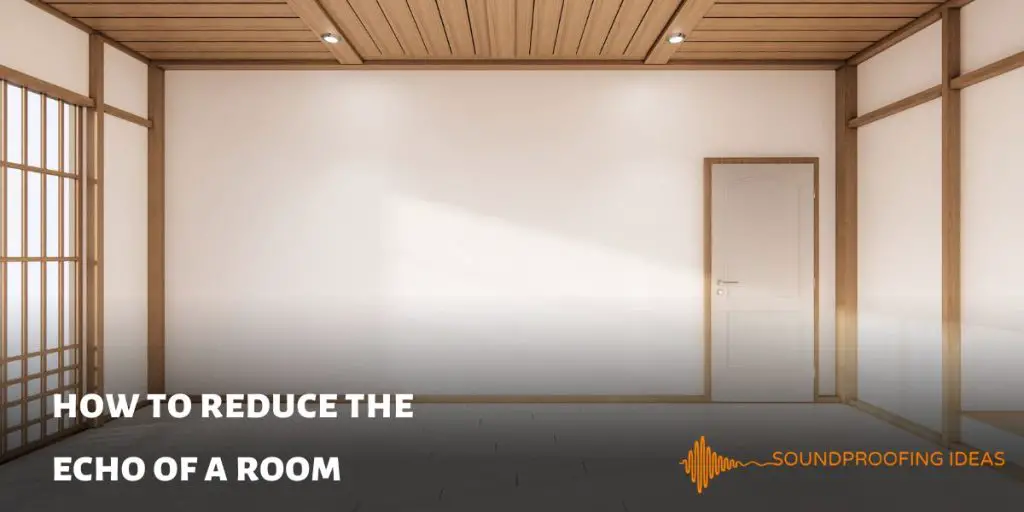Does the interior of your house or apartment tend to resonate and this tires you on a daily basis?
Rest assured, there are simple solutions to put in place to reduce the echo of a room and improve the acoustic comfort of your interior.
Contents
Why does a room resonate?
The principle of sound absorption is defined by the capacity of a room to limit the sounds which are reflected on the materials of the walls, the ceilings, the floors, and the furniture.
Sound absorption will depend on several factors, including air resistance, porosity, and shape and structure of the material.
Thus, a very hard and slightly porous material will reflect sounds more easily than a very porous material.
Sound absorption is a very different principle from sound insulation, which is more concerned with the propagation of noise outside a room.
Concretely, the configuration of a room plays a huge role in its acoustic absorption. Certain configuration elements can thus more easily contribute to poor sound absorption:
- A large area
- A significant ceiling height
- Smooth, parallel walls
- The presence of materials such as place, tiles, concrete, or glass on the walls
- Elements such as radiators or ceramic objects are more likely to resonate
- An “empty” and uncluttered room, with few pieces of furniture, rugs, etc.
These factors will promote the rebound of sound waves on surfaces. If the wave bounces back rather than sinks, it will cause an echo in the room.
Why improve the acoustic quality of a room?
It is important to be able to benefit from optimal acoustic comfort at home. Indeed, we are confronted, during the day, with continuous noise pollution (transportation, work in town, shouting voices in the street or at work, music played at too high a volume, the neighbors’ dog, etc.).
The noise pollution that we experience daily has a detrimental effect on our health: stress, fatigue, irritability, and insomnia.
When we return home, we want to find ourselves in a calm, restful, pleasant place. Acoustic comfort is therefore important insofar as it will make your house or apartment a real cocoon where you can relax, and rest your ears and your brain.
How to reduce the echo of a room?
If you find that a room in your house or apartment resonates a little too much, you can always change its configuration or decoration to improve acoustic comfort and reduce echo:
- Put up wallpaper. The wallpaper will prevent sound waves from bouncing off the walls, so it’s an effective way to reduce echo in your room.
- On the floor, prefer carpet or parquet to tiles. These two types of coating make it possible to limit acoustic reverberation and therefore reduce echoes.
- Add more furniture. If your room is very large and you have decided to decorate it in a clean and minimalist way, with as little furniture as possible, it may not be a good idea because it will favor the echo. To improve the acoustic comfort of your room, do not leave too large empty spaces. Add furniture: a larger sofa, two or three occasional seats, a larger dining table, side tables, storage units, and a bookcase.
- Fill in the gaps with large houseplants. Green plants are part of the decorative elements that will absorb sound waves. Feel free to add some to your room! The larger they are, the more effective they will be at limiting room echoes.
- Accumulate textile decorations. Fabric is also effective at absorbing sound waves. Add as many textiles as possible to your room, such as carpets or curtains. The thicker your carpet, the more sound absorption it will promote in your room.
- For your seats, choose fabric over leather, which has a greater tendency to bounce sound waves.
Sound treatment using sound absorbing panels: is it a good idea?
In some cases, it will be advisable to entrust your room to a professional who will carry out a sound treatment of the surfaces.
For example, if you are a musician, you work from home in a home studio and you really need perfect acoustics without the slightest echo, you will be recommended to use a phonic treatment.
Likewise, if your room is configured in such a way as to optimize your acoustic comfort but a significant echo persists, it is advisable to opt for sound treatment with sound-absorbing panels.
Be careful, if you are a tenant, you cannot decide alone to carry out this type of work in your house or apartment! Talk to your landlord first.
If you are looking for a quick, less restrictive, and less expensive solution for effective results, you can opt for the installation of an absorbent floor covering at ground level.
Carpets and rugs work quite well, as does laying large cushions low to the floor. But for maximum efficiency, it is recommended to put a carpet on your entire floor.
There are also quick and easy solutions to reduce the bouncing of sound waves off the walls. You can thus choose to put thick wallpaper on the four walls of your room or to cover them with wall textiles, curtains, and tapestries. The accumulation of soundproof paintings or canvases can also be effective.
If, however, you prefer to deal with your echo problem at the source, to be definitely at peace of mind but also to benefit from maximum efficiency, opt for sound treatment, call on a professional who will study the configuration of your interior, take the measurements your room and offer you an effective solution for absorbing sound waves.
The sound treatment consists of laying tiles or panels, which can be made of various materials, from melamine resin to felt, including stage velvet, fleece, or polyester wool.

